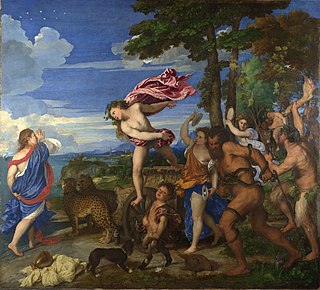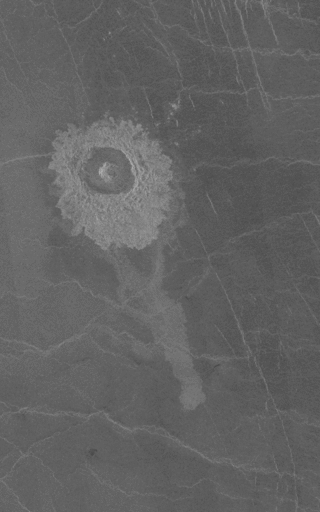
In Greek mythology, Ariadne was a Cretan princess, the daughter of King Minos of Crete. There are different variations of Ariadne's myth, but she is known for helping Theseus escape from the Minotaur and being abandoned by him on the island of Naxos. There, Dionysus saw Ariadne sleeping, fell in love with her, and later married her. Many versions of the myth recount Dionysus throwing Ariadne's jeweled crown into the sky to create a constellation, the Corona Borealis.

HMS Ariadne was a Leander-class frigate of the Royal Navy. She was launched in 1971, was sold to Chile in 1992 and sunk as a target hulk in 2004.

Ariadne auf Naxos, Op. 60, is a 1912 opera by Richard Strauss with a German libretto by Hugo von Hofmannsthal. The opera's unusual combination of elements of low commedia dell'arte with those of high opera seria points up one of the work's principal themes: the competition between high and low art for the public's attention.

Bacchus and Ariadne (1522–1523) is an oil painting by Titian. It is one of a cycle of paintings on mythological subjects produced for Alfonso I d'Este, Duke of Ferrara, for the Camerino d'Alabastro – a private room in his palazzo in Ferrara decorated with paintings based on classical texts. An advance payment was given to Raphael, who originally held the commission for the subject of a Triumph of Bacchus.

Ariadne is a little-known psychoactive drug. It is a homologue of the psychedelics 2C-D and DOM. Ariadne was first synthesized by Alexander Shulgin. In his 1991 book PiHKAL, Shulgin reported testing Ariadne on himself up to a dose of 32 mg, finding that it produced "the alert of a psychedelic, with none of the rest of the package". Very little published data exists about the human pharmacology of Ariadne apart from Shulgin's limited testing; unpublished human trials reportedly observed some psychoactive effects, but no hallucinations.

Batrachyla taeniata is a species of frog in the family Batrachylidae. It is found in Argentina and Chile. Its natural habitats are subantarctic forest, temperate forest, temperate shrubland, subantarctic grassland, temperate grassland, swampland, intermittent freshwater marshes, rocky shores, pastureland, rural gardens, and introduced vegetation. It is threatened by habitat loss.

The buff-breasted mountain tanager is a species of Neotropical bird in the tanager family Thraupidae.

Partula taeniata, common name the Moorean viviparous tree snail, is a species of terrestrial gastropod in the Partulidae family. It is endemic to French Polynesia.
Manzonia taeniata is a species of minute sea snail, a marine gastropod mollusc or micromollusc in the family Rissoidae.

Martania taeniata, the barred carpet, is a moth of the family Geometridae. The species was first described by James Francis Stephens in 1831. It is found in large parts of the Palearctic realm.
In Greek mythology, Psalacantha was a nymph of the island Icaria, who later got turned into a plant by the god Dionysus.

Ariadne is a genus of nymphalid butterflies, commonly called castors, found from Sub-Saharan Africa to South-East Asia. It was erected by Thomas Horsfield in 1829. The genus was named after Ariadne the daughter of Minos, king of Crete.

Ariadne is a crater on Venus. Its central peak serves as the prime meridian of the planet, a status formerly held by Eve Crater until relocated.
Glenea taeniata is a species of beetle in the family Cerambycidae. It was described by James Thomson in 1860. It is known from Malaysia, Borneo and Sumatra.
Hyperaspis taeniata, the ribboned lady beetle, is a species of lady beetle in the family Coccinellidae. It is found in North America.

Ariadnes Colles is a region of colles (hills) in the northeast of Eridania quadrangle of Mars. It is located around 34.5 ° south latitude, and 172.78° east longitude. It covers 180 by 160 kilometers. The feature was named after a classic albedo feature by the IAU in 1982.

SMS Ariadne was a steam corvette of the German Kaiserliche Marine. She was the lead ship of the Ariadne class, which included two other ships, Luise and Freya. Ordered as part of a naval expansion program after the Austro-Prussian War, Ariadne was laid down in September 1868, launched in July 1871, and was commissioned in November 1872. Ariadne was a small vessel, armed with a battery of just eight guns.

Ariadne is a 1913 painting by Italian painter Giorgio de Chirico. Done in oil and graphite on canvas, the painting depicts the mythical figure Ariadne as she lies sleeping in an empty public square; this is in reference to the myth that birthed the character, in which Ariadne is abandoned on Naxos by her lover Theseus. According to sources provided by the Metropolitan Museum of Art, this reflects Chirico's personal feelings of isolation after moving to Paris in 1911.
Prymnessus or Prymnessos, or Prymnesus or Prymnesos (Πρύμνησος), or Prymnesia (Πρυμνησία) was a town of ancient Phrygia. Its site is located near Sülün in Asiatic Turkey.
Betta taeniata is a species of gourami endemic to the Southeast Asian island of Borneo, where it lives in inland waters.













